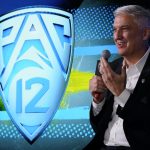In coming days, weeks and months, the Pac-12 will plot a course to salvation … or go the way of the dodo.
A range of outcomes exists following the loss of USC and UCLA to the Big Ten, from merging with a peer conference or expanding its ranks to sticking with 10 schools or vanishing from the landscape altogether.
In an upcoming Hotline series, we’ll plunge into the specific scenarios.
This introductory installment examines five broad issues that will shape our discussions and the future of the conference.
1. Pac-12 presidents: The heat is on
Survival starts at the top, which should be cause for concern across the footprint.
The conference has been pushed to the brink because the presidents and chancellors didn’t prioritize football, signed off on bad media strategies and waited too long to change commissioners.
Now, they must settle on an identity for the reconfigured conference and determine which universities clear the barrier for entry.
Will the membership standards in place for decades continue to exist with regard to academic reputation, political leanings and religious affiliation?
If so, the path forward narrows considerably.
Of all the presidents, we wonder most about Washington’s Ana Mari Cauce, who took over as chair of the Pac-12 board on Friday.
If the Huskies eventually negotiate behind-the-scenes for invitations to the Big Ten or Big 12, that’s a massive conflict of interest.
2. Anxious days, worrisome nights
The next two weeks are vital. “We need things to slow down,” one Pac-12 source said, in order for a level of trust and sanity to return.
At the moment, conference and campus leaders gather on Zoom calls and wonder who’s truly committed and whose face they might be seeing for the last time.
The Big Ten appears finished with expansion, for now, so our focus turns to the Big 12 and its level of aggression.
A year ago, the situation was reversed. Texas and Oklahoma had announced plans to move to the SEC, and the Big 12 was fighting for survival.
The Pac-12 declined to merge but, by not poaching the most desirable schools, allowed the Big 12 to survive.
Will the emboldened Big 12 turn around and attempt a kill shot, or return the favor and stand down?
3. Media partner motivation
For 10 years, Fox and ESPN have been equal owners of the Pac-12’s media rights.
That shared interest probably won’t continue once the current contract expires in the spring of 2024.
Fox orchestrated what could be the knockout blow and is the puppet-master behind the Big Ten’s raid of the Los Angeles schools.
The move suggests that Fox will have little interest in Pac-12 media rights in the next contract cycle. Most, if not all of its cash will be spent on the Big Ten and the expanded College Football Playoff.
Meanwhile, ESPN could play a key role in rescuing the Pac-12.
When the next contract cycle begins, ESPN will control all ACC and SEC football content but perhaps very little — or none — of the Big Ten’s inventory.
That’s significant, because ESPN has more shelf space than Fox due to additional linear networks (ESPN2) and its commitment to a digital platform (ESPN+).
It needs viable college football in the Central, Mountain and Pacific time zones in order to fill all those broadcast windows.
Given the desperation level of the Pac-12 and Big 12, whose current media deal expires in 2025, their inventory will undoubtedly be available for whatever price ESPN is willing to pay.
ESPN can name the terms and, if desired, dictate which schools are in which league.
4. The tent pole schools
Of the 80-something major college football programs not bound to the SEC, Big Ten or ACC — and are not Notre Dame — the Pac-12 owns the two most valuable in the media marketplace: Washington and Oregon.
If we assume the door to the Big Ten is closed and the Huskies and Ducks are committed to the Pac-12, if only for lack of ideal options, they provide real leverage.
Leverage the conference can use with ESPN or other interested media companies.
Leverage the conference can use with schools in the Big 12 or Mountain West that might be expansion targets.
Leverage the conference can use with current Pac-12 schools pondering a jump to the Big 12.
With the Huskies and Ducks, there is a foundation to move forward.
The Pac-12 must make optimum use of its purple and green carrots.
UCLA’s separation from Cal — the campuses share the same university system and board of regents — is one of our lingering curiosities about the L.A. departures.
And the future of the Pac-12 could hinge on the degree to which remaining state schools are bound to move in lockstep.
Could Arizona State bolt for the Big 12 and leave Arizona behind?
Could Washington head to the Big Ten (eventually) and kiss WSU goodbye?
Could Oregon do whatever Phil Knight wants without regard for Oregon State?
Political forces vary by the state, and we won’t begin to guess how each situation could play out.
But it’s a key piece to the Pac-12’s future shape … or disappearance.
Related posts:

(AP Photo/Ralph Freso, File)
Pac-12 Spring Football Breakdown. Key Questions for Each Team Wilner Hotline: Bowl Predictions After One Month
Wilner Hotline: Bowl Predictions After One Month

(AP Photo/Marcio Jose Sanchez)
Wilner Hotline – Pac-12 men’s basketball preview: It’s a three-team race for the top (unless COVID decides otherwise)
(AP Photo/Nell Redmond)
Pac-12 MBB power ratings: Arizona on top, WSU surges as road teams flounder (we have the data)

